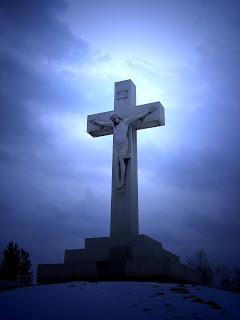Good Friday

Good Friday is the Friday before Easter or Pascha. It commemorates the crucifixion and death of Jesus at Calvary. This year, it is on April 6, 2007.
Good Friday is a holy day observed by most Christian religions. Special prayer services are often held on this day with readings from the Gospel giving accounts of the events leading up to the crucifixion. Mainstream Christian churches view Christ's crucifixion as a voluntary and vicarious act, and one by which, along with resurrection on the third day, death itself was conquered.
Roman Catholic Christians treat Good Friday as a fast day, which is defined as only having one large meal (but still smaller than a regular meal) and two small ones not equaling the large one. In the United States, it is not a day of abstention from work however; people work until shortly before the beginning of the afternoon liturgy. In Latin America, all Catholics have work abstention on Good Friday (as well as Holy Thursday, the day of the last supper).
The Catholic Good Friday in the Roman Rite afternoon liturgy - held around 3 p.m., the time Christ is said in the bible to have died, in those countries where Good Friday is a public holiday - involves a series of readings and meditations, as well as the (sung) reading of the Passion account from the Gospel of John which is often read dramatically, with the priest, one or more readers, and the congregation all taking part. In the traditional Latin liturgy, the Passion is read by the priest facing the altar, with three deacons chanting in the sanctuary facing the people. Unlike Roman Catholic services on other days, the Good Friday liturgy is not a Mass as it lacks the consecration, the central element to the Mass, and in fact, celebration of Catholic Mass on Good Friday is forbidden; unlike the Eastern Churches, the feast of the Annunciation is moved to the week after Easter if it should fall on Good Friday. Eucharist consecrated the night before (Holy Thursday) may be distributed (otherwise, it is only available as viaticum for the dying). The violet draping is removed from a Crucifix (not required to be the same one which is on or near the altar at other times of the year) with the people given an opportunity to venerate it. The services also include a long series of formal intercessions. The solemnity and somberness of the occasion has led to a phenomenon whereby in the course of history the liturgical provisions have a tendency to persist without substantial modification, even over the centuries (Anton Baumstark). In some countries, such as Malta, Italy, Philippines and Spain, processions with statues representing the Passion of Christ are held.For those among us who are not catholic, or were interested.
TomC


No comments:
Post a Comment